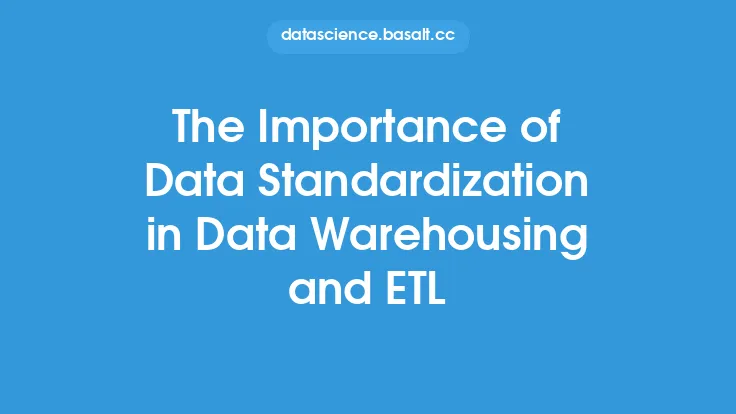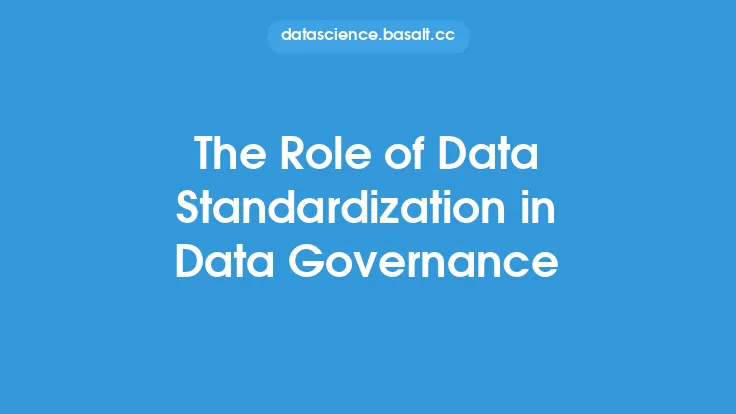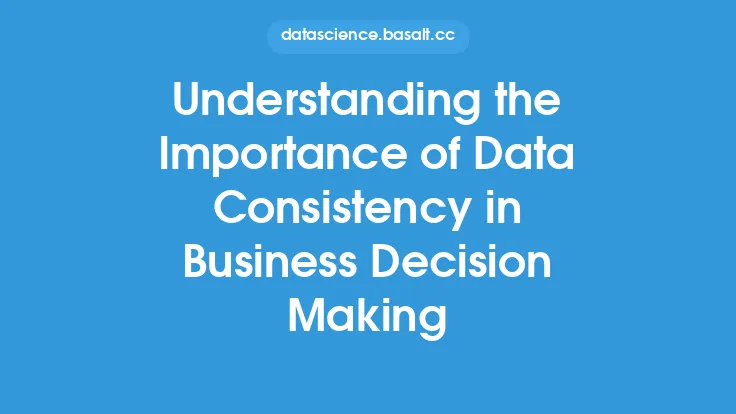In today's data-driven world, businesses are generating and collecting vast amounts of data from various sources, including customer interactions, transactions, and market trends. This data has the potential to provide valuable insights and drive business decisions, but only if it is properly managed and analyzed. One crucial aspect of effective data management is data standardization, which plays a vital role in business intelligence. Data standardization refers to the process of establishing a common format, structure, and definition for data elements across an organization, ensuring that data is consistent, accurate, and reliable.
What is Data Standardization?
Data standardization involves creating a set of rules, guidelines, and protocols for collecting, storing, and processing data. This includes defining data formats, data types, and data structures, as well as establishing common terminology and definitions. The goal of data standardization is to ensure that data is consistent and comparable across different systems, departments, and locations, making it easier to analyze and interpret. Standardized data also enables organizations to integrate data from different sources, reducing data silos and improving data sharing and collaboration.
Benefits of Data Standardization
Data standardization offers numerous benefits to organizations, including improved data quality, increased efficiency, and enhanced decision-making. Standardized data reduces errors and inconsistencies, making it more reliable and trustworthy. It also enables organizations to automate data processing and analysis, freeing up resources for more strategic and value-added activities. Additionally, standardized data facilitates data sharing and collaboration, breaking down silos and enabling different departments and teams to work together more effectively. By providing a common language and framework for data, standardization also enables organizations to communicate more effectively with stakeholders, including customers, partners, and regulators.
Technical Aspects of Data Standardization
From a technical perspective, data standardization involves several key components, including data modeling, data governance, and data quality control. Data modeling involves creating a conceptual representation of data, including entities, attributes, and relationships. This helps to establish a common understanding of data and ensures that data is structured and organized in a consistent and logical manner. Data governance refers to the policies, procedures, and standards that govern data management, including data security, data privacy, and data compliance. Data quality control involves monitoring and ensuring the accuracy, completeness, and consistency of data, using techniques such as data validation, data cleansing, and data normalization.
Data Standardization in Business Intelligence
In the context of business intelligence, data standardization is critical for enabling effective data analysis and decision-making. Business intelligence involves using data and analytics to inform business decisions, identify trends and patterns, and optimize business performance. However, this requires high-quality, standardized data that can be easily analyzed and interpreted. Standardized data enables organizations to create consistent and accurate reports, dashboards, and visualizations, providing stakeholders with a clear and comprehensive understanding of business performance. It also enables organizations to apply advanced analytics and machine learning techniques, such as predictive modeling and data mining, to uncover hidden insights and drive business innovation.
Challenges and Opportunities
Despite the importance of data standardization, many organizations face challenges in implementing and maintaining standardized data. These challenges include legacy systems and data silos, cultural and organizational barriers, and limited resources and expertise. However, these challenges also present opportunities for organizations to innovate and improve their data management practices. By adopting cloud-based data management platforms, leveraging artificial intelligence and machine learning, and developing data-driven cultures, organizations can overcome these challenges and unlock the full potential of their data. Additionally, emerging technologies such as blockchain and the Internet of Things (IoT) are creating new opportunities for data standardization, enabling organizations to create secure, transparent, and decentralized data ecosystems.
Best Practices for Data Standardization
To achieve effective data standardization, organizations should follow several best practices, including establishing a data governance framework, defining clear data standards and policies, and implementing data quality control processes. Organizations should also engage stakeholders and promote a data-driven culture, providing training and education on data management and analysis. Additionally, organizations should leverage technology and automation to streamline data processing and analysis, using tools such as data integration platforms, data warehouses, and business intelligence software. By following these best practices, organizations can ensure that their data is accurate, consistent, and reliable, providing a solid foundation for business intelligence and decision-making.
Conclusion
In conclusion, data standardization is a critical component of effective data management and business intelligence. By establishing a common format, structure, and definition for data elements, organizations can ensure that their data is consistent, accurate, and reliable. This enables organizations to integrate data from different sources, reduce data silos, and improve data sharing and collaboration. While there are challenges to implementing and maintaining standardized data, these challenges also present opportunities for innovation and improvement. By following best practices and leveraging technology and automation, organizations can unlock the full potential of their data and drive business success. As data continues to play an increasingly important role in business decision-making, the importance of data standardization will only continue to grow, making it a critical aspect of any organization's data management strategy.





